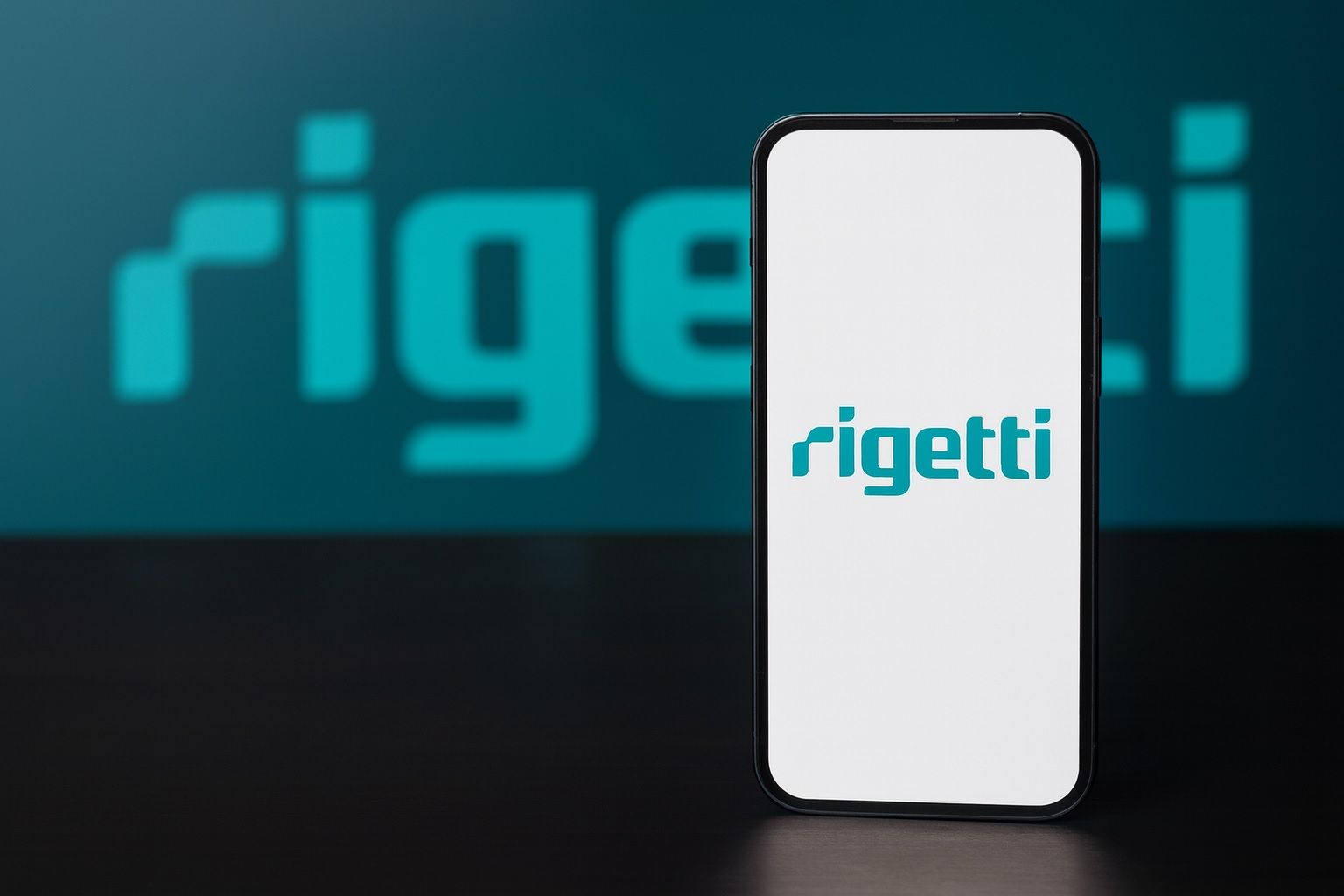- Spectacular Surge: Rigetti Computing’s stock (NASDAQ: RGTI) has rocketed by roughly 5,000% over the past year, exploding from penny-stock levels under $1 to an all-time high around $56 per share last week [1]. This meteoric rise put RGTI’s market cap in the mid-teens of billions of dollars, with a 52-week range spanning mere cents to nearly $58 [2]. Few stocks have ever climbed so far, so fast.
- Recent Pullback: After peaking on October 15, Rigetti’s quantum rocket hit turbulence. The stock plunged about 25% in just a few sessions as traders took profits and broader market jitters set in. By October 21, RGTI had slipped back to the mid-$40s (closing at $43.31 on Oct. 20) [3] and ended around $40 by Tuesday’s close after another -7.6% drop [4]. Even with this pullback, shares remain astronomically higher year-over-year [5] – underlining both the thrill and peril of such a volatile stock ride.
- Rally Fuelled by Deals:Real-world wins ignited investor enthusiasm. In late September, Rigetti secured a $5.8 million U.S. Air Force contract (with partner QphoX) to develop quantum networking technology, and notched $5.7 million in orders for two of its new Novera quantum computers – the company’s first significant commercial hardware sales [6]. It also launched a new 36-qubit quantum processor on its cloud platform [7]. Each announcement lent credibility to Rigetti’s tech and helped supercharge the stock’s ascent. Additionally, a JPMorgan $10 billion tech initiative (announced Oct. 16) to invest in frontier areas like quantum computing boosted sector-wide optimism [8].
- Bubble Worries: Despite Rigetti’s multi-billion valuation, its revenues are minuscule – on the order of $8–10 million a year, with deep losses [9]. At last week’s peak, the stock traded at an eye-popping 1,500×+ sales multiple [10]. This huge disconnect between soaring stock price and modest fundamentals has experts warning of a potential quantum bubble. A Seeking Alpha analyst bluntly labeled RGTI “massively overvalued,” given its ~$17–18 B market cap “despite questionable fundamentals and no near-term path to profitability” [11]. Even bullish Wall Street analysts, who universally rate Rigetti a Buy for its long-term promise, have 12-month price targets in the mid-$20s – roughly 50% below recent trading levels [12]. In other words, analysts see the stock overextended, cautioning that the parabolic run-up “may be unsustainable” without major breakthroughs [13].
- Quantum Peers Also Soaring: Rigetti’s wild ride is part of a broader quantum computing stock rally lifting its peers – though none quite to Rigetti’s extremes. Rival IonQ (IONQ), which uses trapped-ion qubit tech, is up about 700% year-over-year, and D-Wave Quantum (QBTS) (quantum annealing specialist) has skyrocketed 3,000–4,000% from penny-stock levels [14] [15]. These are enormous gains in their own right, yet Rigetti’s ~50× surge overshadows them all [16]. Like Rigetti, other pure-play quantum names (IonQ, D-Wave, Quantum Computing Inc.) now sport inflated valuations despite tiny revenues, leading observers to lump them together as a potentially overhyped group [17]. Even Barron’s has cautioned that quantum computing stocks have risen “nearly fourfold on average over the past year” despite limited commercial use and little revenue – a bubble that “may keep inflating until it is tested by fundamentals.” [18]
Stock Rollercoaster: From Penny Stock to $50+ and Back to $40
Rigetti Computing’s stock price action in 2025 has been nothing short of extraordinary. At the start of the year, RGTI traded for mere cents. Fast forward to mid-October, and the stock hit a high of $56.34 on October 15, representing an almost 50-fold increase in under a year [19]. In one frenzied session on Oct. 13, Rigetti spiked 25% in a day, catapulting its market cap into the tens of billions [20]. This speculative quantum frenzy pushed Rigetti far beyond the gains of other hot tech plays – even outpacing the year’s AI stock mania.
However, the rally proved as volatile as it was euphoric. After peaking last week, reality struck: on Oct. 16, RGTI plunged roughly 15% in a single day as early investors rushed to lock in profits [21]. That sell-off continued into the next trading sessions. By Monday Oct. 20, Rigetti fell another -6.6% to close at $43.31 [22], and on Tuesday Oct. 21 it slid further to around $40 at close [23]. All told, the stock gave back about a quarter of its value in a matter of days – a swift reversal, yet arguably a “healthy breather” given the monstrous run-up.
Notably, no bad news from Rigetti’s operations catalyzed this sudden drop. There was no earnings miss or failed experiment; rather, the retreat appeared driven by technical and market factors. Analysts note that after such a parabolic ascent, some pullback was inevitable once the stock became overbought [24]. A bout of broader market volatility – including an unrelated banking sector scare on Oct. 16 – also spooked traders, prompting a rush out of speculative names like RGTI [25]. In short, the gravity of fundamentals kicked in: stocks (even “quantum” ones) don’t go up in a straight line forever. Traders seized on any excuse to take profits. News also emerged that Rigetti’s CEO, Subodh Kulkarni, had quietly sold 1,000,000 shares earlier in the year, essentially liquidating his personal stake [26]. That insider sale – telegraphing a lack of “skin in the game” by the chief executive – added to jitters and likely contributed to the wave of profit-taking.
As of October 22, the dust is still settling. Rigetti stock is hovering around the low-$40s, dramatically down from last week’s high but still astronomically higher than a year ago [27]. For context, even after the pullback, RGTI has returned many times over any reasonable 2025 starting price. The question now is whether this was just a speed bump on the way to even greater heights – or the start of a larger reality check for a stock priced to perfection.
What’s Driving Rigetti: Quantum Deals, Hype and Milestones
So how did Rigetti capture investors’ imaginations to such an extreme degree? In large part, it’s the company’s steady drumbeat of positive news in the red-hot field of quantum computing. Over the past few months, Rigetti has announced a string of headline-grabbing deals and technical breakthroughs that helped validate its prospects – and justified some of the hype propelling its stock:
- Major Government Contracts: In late September, Rigetti (in partnership with Dutch startup QphoX) won a $5.8 million contract from the U.S. Air Force to develop quantum networking technology [28]. This three-year Air Force R&D project not only provides non-dilutive funding, but also confers credibility – a sign that major institutions see practical value in Rigetti’s tech. Around the same time, Rigetti was selected by the UK’s National Quantum Computing Centre to supply hardware for its quantum program [29], reinforcing the company’s status as a key player in government-backed quantum initiatives.
- First Commercial Sales: Rigetti revealed it secured purchase orders totaling $5.7 million for two of its new “Novera” quantum computers, to be delivered in 2026 [30]. Notably, these are the company’s first-ever sales of full quantum systems to customers (reportedly an Asia-based manufacturer and a U.S. AI startup). For a firm that previously generated only a few million dollars in annual revenue, these orders marked a pivotal commercial milestone – tangible proof that Rigetti can monetize its technology, not just conduct research. Each such real-world win fed the narrative that Rigetti’s long-term “quantum ambitions” are turning into tangible progress [31], thereby attracting more investor interest.
- Technology Milestones: Rigetti has also been rolling out advancements in its core tech. It launched a new 36-qubit quantum processor on its cloud platform this fall, marking a step forward in performance from its previous generation systems [32]. The company has articulated a roadmap to scale to 1,000+ qubits in coming years, aiming for ever more powerful quantum chips. It even struck a partnership with NVIDIA to integrate Rigetti’s quantum solutions with NVIDIA’s hybrid quantum-classical computing tools [33]. Such partnerships with established tech giants lend further credibility and signal that Rigetti is gearing up to tackle real-world applications with help from industry leaders.
- Ample Cash and Funding: Unlike many tiny tech outfits, Rigetti entered this boom with a relatively strong cash position (bolstered by its SPAC merger in 2022). It reportedly has around $571 million in cash reserves on hand [34] – a war chest to fund R&D for several years. This has reassured some investors that Rigetti can survive the long march toward viable quantum computing without immediate dilution. The company also highlighted $21 million in contracts for 2025 (including the deals above), indicating a growing revenue pipeline [35]. All this made for a compelling storyline that Rigetti is one of the more financially and technologically prepared of the quantum start-ups.
- Sector-Wide Catalysts: Rigetti’s rally has been abetted by broader excitement in quantum tech. For example, on Oct. 16, banking giant JPMorgan Chase announced a $1.5 trillion initiative for strategic technologies (like AI and quantum) and pledged up to $10 billion for direct investments in companies in these sectors [36]. This news sent a jolt through all quantum computing stocks, including RGTI, by signaling that big institutional money is eyeing the space. Similarly, media buzz – from a Nobel Prize related to quantum science to high-profile research breakthroughs at competitors – has kept quantum computing in the headlines. In short, quantum became the “next big thing” after AI in 2023–2025, and Rigetti’s stock benefited enormously from being one of the few pure-plays available to public investors.
It’s important to note that none of these developments alone can justify a 50x stock price explosion. Rather, they have provided a plausible narrative for investors betting that Rigetti could be a future winner in an industry with transformative potential. Each contract or partnership added fuel to the idea that Rigetti is turning science-fiction-like tech into a commercial reality – an intoxicating story for the market. As one analyst put it, “the narrative that Rigetti’s quantum ambitions are turning into tangible progress” has been a key driver of its rapid ascent [37]. In essence, hype builds on hope, and Rigetti has given the market just enough concrete progress to stoke tremendous speculative flames.
Rivals and Reality: Rigetti vs. IonQ, D-Wave, and Big Tech
Rigetti is not flying solo in the quantum race. A handful of other quantum computing stocks have also shot up this year, riding the same wave of investor enthusiasm – though each with its own twist. Understanding Rigetti’s competitive landscape provides context for whether its valuation is justified or overheated:
- IonQ (NYSE: IONQ): IonQ is another high-profile quantum startup (using trapped-ion technology rather than Rigetti’s superconducting qubits). Its stock is up roughly 6–8× (600–700%) in the past year [38] [39] – a spectacular gain, if not as astronomical as Rigetti’s. Investors have rewarded IonQ for steady technical progress (the company has repeatedly announced improvements in its quantum systems’ power) and for blue-chip partnerships – IonQ works with Amazon, Google, Hyundai, and others. IonQ’s market cap, while lofty (in the single-digit billions), looks almost “reasonable” next to Rigetti’s richer valuation [40]. Some observers see IonQ as a somewhat more mature player with a clearer near-term roadmap, possibly explaining why its stock hasn’t swung as wildly as RGTI. Nonetheless, IonQ shares have experienced their own volatility and, like Rigetti, trade at revenue multiples that assume massive future growth.
- D-Wave Quantum (NYSE: QBTS): D-Wave, a Canadian firm specializing in a different approach called quantum annealing, was even more of a penny stock before the recent boom. Its shares have skyrocketed from under $0.50 to around $10+ in the past year – a mind-bending 2,000–4,000% increase [41] [42]. By some counts, D-Wave has delivered the largest percentage gain of the “Quantum Four” this year. D-Wave’s rally was fueled partly by new international partnerships and sympathy gains whenever Rigetti or IonQ jumped. However, D-Wave’s technology is less general-purpose (quantum annealers solve optimization problems and may not scale to universal computing), which has drawn skepticism from some analysts. The company also endured short-seller attacks earlier in the year. In short, D-Wave’s surge shows the speculative fervor in quantum stocks, but its long-term story is quite uncertain. Like Rigetti, D-Wave has minimal revenue and significant cash burn, meaning it will need continual funding until the tech matures [43].
- Quantum Computing Inc. (NASDAQ: QUBT): Another small-cap in the space, QUBT has also enjoyed a huge lift (its stock is up several hundred percent this year). QUBT is smaller and less liquid than the others, essentially riding the sector’s coattails. All told, the pure-play quantum stocks – Rigetti, IonQ, D-Wave, QUBT – have delivered eye-popping one-year gains ranging from +700% to +6,000% [44]. This entire group has been buoyed by speculative hype around “the next computing revolution.” But importantly, they also share common red flags: extremely low revenues (often under $10M annually), ongoing big losses, and the need to continuously raise cash to fund R&D [45]. In effect, public market investors have been valuing these companies more on dreams of future dominance than on any current financial performance.
- IBM, Google, and the Tech Giants: While the startups grabbed headlines for their stock spikes, the established tech titans are also deeply invested in quantum – though their stock prices haven’t gone haywire like the pure-plays. IBM (NYSE: IBM) has been a pioneer in quantum computing for years, unveiling a 127-qubit processor in 2021 and a 433-qubit chip in 2022. IBM’s stock saw a modest boost this year – it was notably the Dow’s best performer in September amid excitement over its quantum advancements [46]. However, as a $100+ billion diversified company, IBM’s valuation isn’t driven solely by quantum news (its quantum division is just one piece of a much larger pie). Similarly, Alphabet (Google’s parent) and Microsoft are pouring billions into quantum research – from Google’s famous quantum supremacy experiments to Microsoft’s work on exotic topological qubits. These giants have vast resources and patience, and they pose a long-term competitive threat to smaller players like Rigetti [47]. They can afford to attract top talent, invest for a decade with little revenue, and perhaps swoop in to acquire or outcompete the startups once the technology is nearer to fruition.
- Friend or Foe? (Partnerships with Big Tech): Importantly, the relationship between big tech and pure-plays isn’t purely adversarial. In fact, companies like Rigetti partner with the giants. For example, Amazon’s AWS cloud offers Amazon Braket, a service giving users access to quantum hardware from various providers – including Rigetti and IonQ – even as Amazon develops its own quantum processors [48]. This collaboration gives startups access to customers and credibility, while Amazon can offer quantum capabilities without building everything in-house immediately. Likewise, Rigetti’s teaming up with NVIDIA (for quantum-classical hybrid computing) shows it can work alongside larger tech firms. However, the big players’ involvement is a double-edged sword: on one hand, their interest validates the market and brings investment; on the other, if companies like IBM/Google/Amazon achieve breakthroughs, they could dominate the industry and leave little room for independent upstarts [49] [50]. Notably, famed investor Warren Buffett has so far avoided any direct bets on pure-play quantum startups – but Berkshire Hathaway does own a stake in Amazon, leading some to quip that “Buffett’s favorite quantum computing stock” is essentially Amazon [51]. Many conservative investors prefer to get quantum exposure through big, established tech companies rather than speculative small-caps, and Buffett’s stance underscores that viewpoint.
In summary, Rigetti’s rise must be viewed in the context of a sector-wide phenomenon. Quantum computing is a field of immense promise, and all these stocks are rallying on future potential rather than present profits. That makes comparisons tricky – none of the pure-plays have a solid financial footing yet, so valuations are based on intangibles like technological milestones, partnerships, and investor sentiment. Rigetti managed to excite the market more than its peers, perhaps due to its particular string of news and its full-stack approach. But the risks facing Rigetti – high cash burn, heavy competition, years of R&D ahead – are not unique; they apply to IonQ, D-Wave, and others as well. This whole group could be swept higher by continued quantum hype, or just as easily sink if the narrative sours.
Analysts’ Take: High Hopes, Red Flags, and Price Targets
Despite the sky-high stock price, Wall Street analysts covering Rigetti generally remain optimistic about the company’s long-term prospects – but many concede that the current valuation is tough to justify near-term. Every major analyst who officially covers RGTI rates it a “Buy” or equivalent, reflecting consensus that Rigetti’s quantum technology holds huge promise down the road [52]. However, tellingly, those same analysts have an average 12-month price target in the $25–$30 range [53]. That is roughly 50% below where the stock traded at its recent highs – in essence, even the bulls on Wall Street expect a sizable cooling-off from current levels. The message: great company, maybe not a great price (for now).
Several analysts have cautioned that Rigetti’s fundamentals need to catch up with the hype. The company’s annual revenue is under $10 million, whereas its market cap, even after the pullback, is well into the double-digit billions [54]. One Seeking Alpha commentator went so far as to call RGTI “massively overvalued” and a Strong Sell at recent prices, given the lack of profitability or near-term business volume to support such a valuation [55]. A recent Barron’s piece likewise flagged that the group of quantum stocks (Rigetti, IonQ, etc.) is trading on dreams, noting that the sector’s market caps have run far ahead of reality – a situation where investors could be “at risk of getting burned” if the bubble pops [56]. The Barron’s authors pointed out that these stocks have soared fourfold on average in a year despite “limited commercial use” for the tech and scant revenues, suggesting the quantum rally may be outpacing what the companies actually deliver [57].
Even some of Rigetti’s supporters warn against irrational exuberance. Benchmark Capital, for example, did raise its price target on RGTI from $20 to $50 during the October rally – a very bullish call that helped ignite further gains [58]. But many other analysts strike a more cautious tone, recommending that new investors perhaps wait for a pullback or tangible progress before jumping in. As TS² (TechStock²) reported, “even bullish analysts warn the stock’s parabolic run may be unsustainable,” and some suggest it “might be too early” to buy at these heights absent a major breakthrough or a significant dip in price [59]. In other words, the professionals covering Rigetti are trying to temper expectations: they believe in the technology and the company’s potential, but they also see the current market euphoria as fragile.
On the flip side, there are voices and models predicting that the rally isn’t necessarily over. In fact, the recent volatility hasn’t dissuaded momentum-focused forecasters from extrapolating further gains. For instance, one quantitative model (cited by StockInvest.us) suggests that if the uptrend resumes, RGTI could rise another ~160% in the next three months, potentially trading between $82 and $150 by early 2026 [60]. Such projections underscore the upside scenario if enthusiasm reignites – essentially betting that the “greater fool theory” will keep pushing the stock higher in the short term. It’s a bold outlook, and certainly not a consensus view, but it illustrates how sharply opinions diverge on Rigetti’s trajectory. Will momentum carry it to new heights, or will fundamentals impose a reality check? At this point, the forecasts span a wide spectrum. Rigetti itself has an earnings report due in a few weeks (scheduled for November 11, 2025), which might provide clues as to how its business is developing – any surprises there (good or bad) could sway analyst models and investor sentiment alike.
Outlook: Quantum Dreams vs. Economic Reality
Looking ahead, Rigetti finds itself at a crossroads common to many breakthrough tech darlings: Can it turn revolutionary potential into a sustainable business? In the near term, investors should brace for continued rocky trading. The stock’s steep pullback in recent days may not be the last; swings of 10% (or more) in a single session have become almost routine for RGTI, and that turbulence will likely persist. “In the short term, the market is likely to remain highly volatile,” one market analysis observed, noting that quantum stocks will gyrate with each new headline and shifting sentiment [61]. Any fresh piece of news – a technological breakthrough, a big contract win, a partnership, or conversely an industry setback or broader market sell-off – could send Rigetti’s stock soaring anew or plunging sharply on a given day. In other words, expect the rollercoaster to continue in the immediate future.
The medium- to long-term trajectory for Rigetti is much harder to predict and is where opinions truly diverge. On one hand, the vision behind Rigetti is genuinely exciting: quantum computers promise the ability to solve problems in minutes that would take classical supercomputers millennia [62]. If Rigetti can be at the forefront of making that vision a reality, the impact (and eventual profits) would be enormous – potentially transforming industries from cryptography to drug discovery. Rigetti’s full-stack approach (designing chips, software, and cloud services in-house) and its early contracts put it in a position to be a big winner if quantum computing achieves its potential [63]. This is the dream that current investors are buying into.
But that “if” looms large. Most experts agree that truly practical, error-corrected quantum computers are still years away – some say not until the 2030s or even 2040 [64]. In the meantime, companies like Rigetti face what’s been termed a long “quantum winter”: a period where they must keep burning cash on R&D, overcoming scientific hurdles, and inching toward viability, all without significant revenue flowing in [65]. During this slog, they will likely have to raise more capital (diluting existing shareholders) or find deep-pocketed partners to stay afloat. Rigetti does have a hefty cash reserve now, but at its current loss rate (over $150M net loss in the last 12 months [66]), that money will eventually dwindle if profits don’t materialize. The risk is that hype cools before the technology catches up, leaving the stock overvalued and vulnerable.
For Rigetti’s stock, the coming months will be a critical sentiment test. Will traders regain their appetite and push it back toward new highs on quantum optimism? Or will the reality of slow fundamental progress set in, potentially driving a deeper correction? It’s entirely possible that RGTI’s recent stumbles are just a “healthy breather” before another leg up, especially if the company announces a new leap in qubit count or lands a marquee commercial client. Conversely, it’s also possible this was the start of the air coming out of a quantum bubble, especially if macroeconomic conditions turn unfavorable for high-risk tech bets.
Either way, prospective investors should approach Rigetti with eyes open to both the enormous opportunity and the substantial risks. The stock’s story so far has been one of “wildly rewarding but perilously uncertain” swings [67]. As the old investing adage goes, trees don’t grow to the sky – exponential gains eventually encounter gravity. Rigetti’s challenge will be to prove that its valuation can be justified by real progress: delivering on its contracts, advancing its 84- and 128-qubit prototypes toward the 1,000-qubit goal, and maybe even discovering a “killer app” that can drive revenue in the interim. Success on those fronts could allow the company to grow into its valuation over time.
In contrast, any missteps – delays, technological disappointments, or even just the passage of time without clear breakthroughs – could weigh heavily on such a richly valued stock. The broader quantum industry’s trajectory will also influence Rigetti. If quantum computing continues to captivate imaginations (much like AI has), Rigetti and its peers could retain support despite their fundamentals, essentially riding the wave of futurism. If, however, the narrative shifts to skepticism, these stocks might face a harsh reckoning.
In summary, Rigetti Computing has given investors a thrilling ride in 2025, encapsulating both the “quantum leap” of next-gen tech potential and the sobering reality of market hype. The company’s achievements and plans suggest a bright long-term future for quantum computing, but the current stock price reflects extreme optimism. Short-term traders may continue to enjoy big swings and momentum plays in RGTI. Long-term investors, on the other hand, will be watching closely to see if Rigetti can gradually turn its scientific prowess into a sustainable, profitable enterprise. The stakes are high: as one expert noted, the quantum revolution is underway, and pioneers like Rigetti are attempting to ride a new frontier that could be tremendously rewarding but comes with no guarantees [68]. In the months ahead, we’ll learn whether Rigetti’s stock can stabilize and grow more organically – or whether this quantum bubble deflates as fast as it inflated. Either way, the Rigetti saga is a case study in both the promise and peril of investing at the cutting edge of technology.
Sources: Rigetti press releases and financial filings; TechStock² (TS2.tech) market analysis [69] [70] [71]; Barron’s via TipRanks [72]; Benzinga news reports [73] [74]; StockInvest.us data [75]; Intellectia.ai market recap [76]; Stockanalysis/Forbes report [77]; Seeking Alpha analysis [78].
References
1. ts2.tech, 2. ts2.tech, 3. ts2.tech, 4. intellectia.ai, 5. ts2.tech, 6. ts2.tech, 7. ts2.tech, 8. www.benzinga.com, 9. ts2.tech, 10. ts2.tech, 11. ts2.tech, 12. ts2.tech, 13. ts2.tech, 14. ts2.tech, 15. ts2.tech, 16. ts2.tech, 17. ts2.tech, 18. www.tipranks.com, 19. ts2.tech, 20. ts2.tech, 21. ts2.tech, 22. ts2.tech, 23. intellectia.ai, 24. ts2.tech, 25. ts2.tech, 26. ts2.tech, 27. ts2.tech, 28. ts2.tech, 29. www.benzinga.com, 30. ts2.tech, 31. ts2.tech, 32. ts2.tech, 33. www.benzinga.com, 34. www.benzinga.com, 35. www.benzinga.com, 36. www.benzinga.com, 37. ts2.tech, 38. ts2.tech, 39. ts2.tech, 40. ts2.tech, 41. ts2.tech, 42. ts2.tech, 43. ts2.tech, 44. ts2.tech, 45. ts2.tech, 46. ts2.tech, 47. ts2.tech, 48. ts2.tech, 49. ts2.tech, 50. ts2.tech, 51. ts2.tech, 52. ts2.tech, 53. ts2.tech, 54. ts2.tech, 55. ts2.tech, 56. www.tipranks.com, 57. www.tipranks.com, 58. www.benzinga.com, 59. ts2.tech, 60. ts2.tech, 61. ts2.tech, 62. ts2.tech, 63. ts2.tech, 64. ts2.tech, 65. ts2.tech, 66. stockanalysis.com, 67. ts2.tech, 68. ts2.tech, 69. ts2.tech, 70. ts2.tech, 71. ts2.tech, 72. www.tipranks.com, 73. www.benzinga.com, 74. www.benzinga.com, 75. ts2.tech, 76. intellectia.ai, 77. stockanalysis.com, 78. ts2.tech









